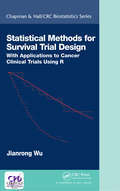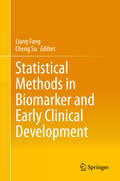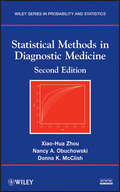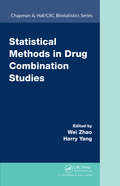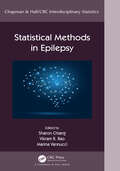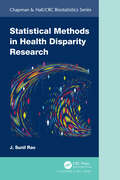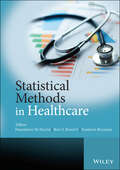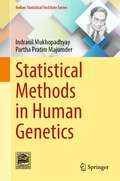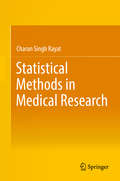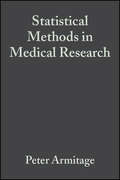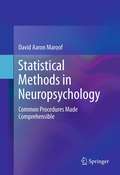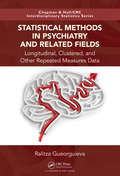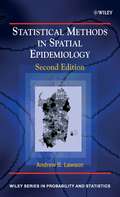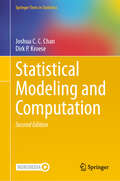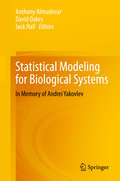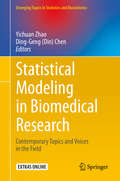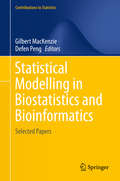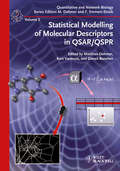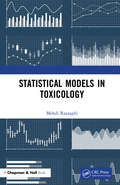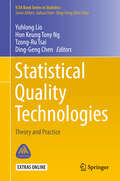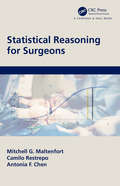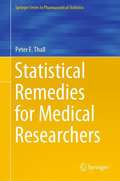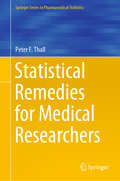- Table View
- List View
Statistical Methods for Survival Trial Design: With Applications to Cancer Clinical Trials Using R (Chapman & Hall/CRC Biostatistics Series)
by Jianrong WuStatistical Methods for Survival Trial Design: With Applications to Cancer Clinical Trials Using R provides a thorough presentation of the principles of designing and monitoring cancer clinical trials in which time-to-event is the primary endpoint. Traditional cancer trial designs with time-to-event endpoints are often limited to the exponential model or proportional hazards model. In practice, however, those model assumptions may not be satisfied for long-term survival trials. This book is the first to cover comprehensively the many newly developed methodologies for survival trial design, including trial design under the Weibull survival models; extensions of the sample size calculations under the proportional hazard models; and trial design under mixture cure models, complex survival models, Cox regression models, and competing-risk models. A general sequential procedure based on the sequential conditional probability ratio test is also implemented for survival trial monitoring. All methodologies are presented with sufficient detail for interested researchers or graduate students.
Statistical Methods in Biomarker and Early Clinical Development
by Liang Fang Cheng SuThis contributed volume offers a much-needed overview of the statistical methods in early clinical drug and biomarker development. Chapters are written by expert statisticians with extensive experience in the pharmaceutical industry and regulatory agencies. Because of this, the data presented is often accompanied by real world case studies, which will help make examples more tangible for readers. The many applications of statistics in drug development are covered in detail, making this volume a must-have reference.Biomarker development and early clinical development are the two critical areas on which the book focuses. By having the two sections of the book dedicated to each of these topics, readers will have a more complete understanding of how applying statistical methods to early drug development can help identify the right drug for the right patient at the right dose. Also presented are exciting applications of machine learning and statistical modeling, along with innovative methods and state-of-the-art advances, making this a timely and practical resource.This volume is ideal for statisticians, researchers, and professionals interested in pharmaceutical research and development. Readers should be familiar with the fundamentals of statistics and clinical trials.
Statistical Methods in Diagnostic Medicine
by Xiao-Hua Zhou Nancy A. Obuchowski Donna K. McclishA new edition of the cutting-edge guide to diagnostic tests in medical research In recent years, a considerable amount of research has focused on evolving methods for designing and analyzing diagnostic accuracy studies. Statistical Methods in Diagnostic Medicine, Second Edition continues to provide a comprehensive approach to the topic, guiding readers through the necessary practices for understanding these studies and generalizing the results to patient populations. Following a basic introduction to measuring test accuracy and study design, the authors successfully define various measures of diagnostic accuracy, describe strategies for designing diagnostic accuracy studies, and present key statistical methods for estimating and comparing test accuracy. Topics new to the Second Edition include: Methods for tests designed to detect and locate lesions Recommendations for covariate-adjustment Methods for estimating and comparing predictive values and sample size calculations Correcting techniques for verification and imperfect standard biases Sample size calculation for multiple reader studies when pilot data are available Updated meta-analysis methods, now incorporating random effects Three case studies thoroughly showcase some of the questions and statistical issues that arise in diagnostic medicine, with all associated data provided in detailed appendices. A related web site features Fortran, SAS®, and R software packages so that readers can conduct their own analyses. Statistical Methods in Diagnostic Medicine, Second Edition is an excellent supplement for biostatistics courses at the graduate level. It also serves as a valuable reference for clinicians and researchers working in the fields of medicine, epidemiology, and biostatistics.
Statistical Methods in Drug Combination Studies (Chapman & Hall/CRC Biostatistics Series #69)
by Wei Zhao Harry YangThe growing interest in using combination drugs to treat various complex diseases has spawned the development of many novel statistical methodologies. The theoretical development, coupled with advances in statistical computing, makes it possible to apply these emerging statistical methods in in vitro and in vivo drug combination assessments. Howeve
Statistical Methods in Epilepsy (Chapman & Hall/CRC Interdisciplinary Statistics)
by Marina Vannucci Sharon Chiang Vikram R. RaoEpilepsy research promises new treatments and insights into brain function, but statistics and machine learning are paramount for extracting meaning from data and enabling discovery. Statistical Methods in Epilepsy provides a comprehensive introduction to statistical methods used in epilepsy research. Written in a clear, accessible style by leading authorities, this textbook demystifies introductory and advanced statistical methods, providing a practical roadmap that will be invaluable for learners and experts alike.Topics include a primer on version control and coding, pre-processing of imaging and electrophysiological data, hypothesis testing, generalized linear models, survival analysis, network analysis, time-series analysis, spectral analysis, spatial statistics, unsupervised and supervised learning, natural language processing, prospective trial design, pharmacokinetic and pharmacodynamic modeling, and randomized clinical trials.Features: Provides a comprehensive introduction to statistical methods employed in epilepsy research Divided into four parts: Basic Processing Methods for Data Analysis; Statistical Models for Epilepsy Data Types; Machine Learning Methods; and Clinical Studies Covers methodological and practical aspects, as well as worked-out examples with R and Python code provided in the online supplement Includes contributions by experts in the field The handbook targets clinicians, graduate students, medical students, and researchers who seek to conduct quantitative epilepsy research. The topics covered extend broadly to quantitative research in other neurological specialties and provide a valuable reference for the field of neurology.
Statistical Methods in Health Disparity Research (Chapman & Hall/CRC Biostatistics Series)
by J. Sunil RaoA health disparity refers to a higher burden of illness, injury, disability, or mortality experienced by one group relative to others attributable to multiple factors including socioeconomic status, environmental factors, insufficient access to health care, individual risk factors, and behaviors and inequalities in education. These disparities may be due to many factors including age, income, and race. Statistical Methods in Health Disparity Research will focus on their estimation, ranging from classical approaches including the quantification of a disparity, to more formal modeling, to modern approaches involving more flexible computational approaches. Features:• Presents an overview of methods and applications of health disparity estimation• First book to synthesize research in this field in a unified statistical framework• Covers classical approaches, and builds to more modern computational techniques• Includes many worked examples and case studies using real data• Discusses available software for estimation The book is designed primarily for researchers and graduate students in biostatistics, data science, and computer science. It will also be useful to many quantitative modelers in genetics, biology, sociology, and epidemiology.
Statistical Methods in Healthcare
by Fabrizio Ruggeri Ron Kenett Frederick FaltinIn recent years the number of innovative medicinal products and devices submitted and approved by regulatory bodies has declined dramatically. The medical product development process is no longer able to keep pace with increasing technologies, science and innovations and the goal is to develop new scientific and technical tools and to make product development processes more efficient and effective. Statistical Methods in Healthcare focuses on the application of statistical methodologies to evaluate promising alternatives and to optimize the performance and demonstrate the effectiveness of those that warrant pursuit is critical to success. Statistical methods used in planning, delivering and monitoring health care, as well as selected statistical aspects of the development and/or production of pharmaceuticals and medical devices are also addressed.With a focus on finding solutions to these challenges, this book:Provides a comprehensive, in-depth treatment of statistical methods in healthcare, along with a reference source for practitioners and specialists in health care and drug development.Offers a broad coverage of standards and established methods through leading edge techniques.Uses an integrated, case-study based approach, with focus on applications.Looks at the use of analytical and monitoring schemes to evaluate therapeutic performance.Features the application of modern quality management systems to clinical practice, and to pharmaceutical development and production processes.Addresses the use of modern Statistical methods such as Adaptive Design, Seamless Design, Data Mining, Bayesian networks and Bootstrapping that can be applied to support the challenging new vision.Practitioners in healthcare-related professions, ranging from clinical trials to care delivery to medical device design, as well as statistical researchers in the field, will benefit from this book.
Statistical Methods in Human Genetics (Indian Statistical Institute Series)
by Indranil Mukhopadhyay Partha Pratim MajumderThis book provides an overview of statistical concepts and basic methodology for the study of genetics of human traits and diseases. It attempts to provide a step-by-step description of problem identification, study design, methodology of data collection, data exploration, data summarization and visualization, and more advanced analytical methods for inferring genetic underpinnings of human phenotypes. The book provides codes in R programming language for implementation of most of the statistical methods described, which will enable practitioners to perform analysis of data on their own, without having to mold the data to fit the requirements of commercial statistical packages. Useful to anyone engaged in studies to understand and manage good health, the book is a useful guide for sustainable development of humankind. Primarily intended for practicing biologists especially those who carry out quantitative biological research, in particular, human geneticists, the book is also helpful in classroom teaching.
Statistical Methods in Medical Research
by Charan Singh RayatThis book covers all aspects of statistical methods in detail with applications. It presents solutions to the needs of post-graduate medical students, doctors and basic medical scientists for statistical evaluation of data. In present era, dependency on softwares for statistical analysis is eroding the basic understanding of the statistical methods and their applications. As a result, there are very few basic medical scientists capable of analyzing their research data due to lack of knowledge and ability. This book has been written in systematic way supported by figures and tables for basic understanding of various terms, definitions, formulae and applications of statistical methods with solved examples and graphic presentation of data to create interest in this mathematical science.
Statistical Methods in Medical Research
by Peter Armitage Geoffrey Berry J. N. MatthewsThe explanation and implementation of statistical methods for the medical researcher or statistician remains an integral part of modern medical research. This book explains the use of experimental and analytical biostatistics systems. Its accessible style allows it to be used by the non-mathematician as a fundamental component of successful research. Since the third edition, there have been many developments in statistical techniques. The fourth edition provides the medical statistician with an accessible guide to these techniques and to reflect the extent of their usage in medical research. The new edition takes a much more comprehensive approach to its subject. There has been a radical reorganization of the text to improve the continuity and cohesion of the presentation and to extend the scope by covering many new ideas now being introduced into the analysis of medical research data. The authors have tried to maintain the modest level of mathematical exposition that characterized the earlier editions, essentially confining the mathematics to the statement of algebraic formulae rather than pursuing mathematical proofs. Received the Highly Commended Certificate in the Public Health Category of the 2002 BMA Books Competition.
Statistical Methods in Neuropsychology
by David Aaron MaroofThis book describes appropriate statistical models that are commonly utilized in neuropsychology. The book discusses such issues as developing normative data for neuropsychological measures, assessing the validity of neuropsychological tests, and quantifying change "over time" through longitudinal analyses. The rationale for and allure of the volume is the fact that there are no publications that dovetail the two subdisciplines of applied statistics and neuropsychology. The overall objective of this book is to provide a pragmatic and concrete source for applying methodological and statistical techniques in research studies whose emphasis includes neuropsychology. Since there are a plethora of technique to arrive at similar answers, each method with its strengths and weaknesses will be delineated. The beauty of the book will be that it will hopefully demystify commonly encountered issues faced with researchers. More specifically, it will provide a "how to do it" approach.
Statistical Methods in Psychiatry and Related Fields: Longitudinal, Clustered, and Other Repeated Measures Data (Chapman & Hall/CRC Interdisciplinary Statistics)
by Ralitza GueorguievaData collected in psychiatry and related fields are complex because outcomes are rarely directly observed, there are multiple correlated repeated measures within individuals, there is natural heterogeneity in treatment responses and in other characteristics in the populations. Simple statistical methods do not work well with such data. More advanced statistical methods capture the data complexity better, but are difficult to apply appropriately and correctly by investigators who do not have advanced training in statistics. This book presents, at a non-technical level, several approaches for the analysis of correlated data: mixed models for continuous and categorical outcomes, nonparametric methods for repeated measures and growth mixture models for heterogeneous trajectories over time. Separate chapters are devoted to techniques for multiple comparison correction, analysis in the presence of missing data, adjustment for covariates, assessment of mediator and moderator effects, study design and sample size considerations. The focus is on the assumptions of each method, applicability and interpretation rather than on technical details. Features Provides an overview of intermediate to advanced statistical methods applied to psychiatry. Takes a non-technical approach with mathematical details kept to a minimum. Includes lots of detailed examples from published studies in psychiatry and related fields. Software programs, data sets and output are available on a supplementary website. The intended audience are applied researchers with minimal knowledge of statistics, although the book could also benefit collaborating statisticians. The book, together with the online materials, is a valuable resource aimed at promoting the use of appropriate statistical methods for the analysis of repeated measures data. Ralitza Gueorguieva is a Senior Research Scientist at the Department of Biostatistics, Yale School of Public Health. She has more than 20 years experience in statistical methodology development and collaborations with psychiatrists and other researchers, and is the author of over 130 peer-reviewed publications.
Statistical Methods in Spatial Epidemiology
by Andrew B. LawsonSpatial epidemiology is the description and analysis of the geographical distribution of disease. It is more important now than ever, with modern threats such as bio-terrorism making such analysis even more complex. This second edition of Statistical Methods in Spatial Epidemiology is updated and expanded to offer a complete coverage of the analysis and application of spatial statistical methods. The book is divided into two main sections: Part 1 introduces basic definitions and terminology, along with map construction and some basic models. This is expanded upon in Part II by applying this knowledge to the fundamental problems within spatial epidemiology, such as disease mapping, ecological analysis, disease clustering, bio-terrorism, space-time analysis, surveillance and infectious disease modelling. Provides a comprehensive overview of the main statistical methods used in spatial epidemiology.Updated to include a new emphasis on bio-terrorism and disease surveillance.Emphasizes the importance of space-time modelling and outlines the practical application of the method.Discusses the wide range of software available for analyzing spatial data, including WinBUGS, SaTScan and R, and features an accompanying website hosting related software.Contains numerous data sets, each representing a different approach to the analysis, and provides an insight into various modelling techniques.This text is primarily aimed at medical statisticians, researchers and practitioners from public health and epidemiology. It is also suitable for postgraduate students of statistics and epidemiology, as well professionals working in government agencies.
Statistical Modeling and Computation (Springer Texts in Statistics)
by Dirk P. Kroese Joshua C. ChanThis book, Statistical Modeling and Computation, provides a unique introduction to modern statistics from both classical and Bayesian perspectives. It also offers an integrated treatment of mathematical statistics and modern statistical computation, emphasizing statistical modeling, computational techniques, and applications. The 2nd edition changes the programming language used in the text from MATLAB to Julia. For all examples with computing components, the authors provide data sets and their own Julia codes. The new edition features numerous full color graphics to illustrate the concepts discussed in the text, and adds three entirely new chapters on a variety of popular topics, including: Regularization and the Lasso regression Bayesian shrinkage methods Nonparametric statistical tests Splines and the Gaussian process regression Joshua C. C. Chan is Professor of Economics, and holds the endowed Olson Chair at Purdue University. He is an elected fellow at the International Association for Applied Econometrics and served as Chair for the Economics, Finance and Business Section of the International Society for Bayesian Analysis from 2020-2022. His research focuses on building new high-dimensional time-series models and developing efficient estimation methods for these models. He has published over 50 papers in peer-reviewed journals, including some top-field journals such as Journal of Econometrics, Journal of the American Statistical Association and Journal of Business and Economic Statistics. Dirk Kroese is Professor of Mathematics and Statistics at the University of Queensland. He is known for his significant contributions to the fields of applied probability, mathematical statistics, machine learning, and Monte Carlo methods. He has published over 140 articles and 7 books. He is a pioneer of the well-known Cross-Entropy (CE) method, which is being used around the world to help solve difficult estimation and optimization problems in science, engineering, and finance. In addition to his scholarly contributions, Dirk Kroese is recognized for his role as an educator and mentor, having supervised and inspired numerous students and researchers.
Statistical Modeling for Biological Systems: In Memory of Andrei Yakovlev
by David Oakes Anthony Almudevar Jack HallThis book commemorates the scientific contributions of distinguished statistician, Andrei Yakovlev. It reflects upon Dr. Yakovlev’s many research interests including stochastic modeling and the analysis of micro-array data, and throughout the book it emphasizes applications of the theory in biology, medicine and public health. The contributions to this volume are divided into two parts. Part A consists of original research articles, which can be roughly grouped into four thematic areas: (i) branching processes, especially as models for cell kinetics, (ii) multiple testing issues as they arise in the analysis of biologic data, (iii) applications of mathematical models and of new inferential techniques in epidemiology, and (iv) contributions to statistical methodology, with an emphasis on the modeling and analysis of survival time data. Part B consists of methodological research reported as a short communication, ending with some personal reflections on research fields associated with Andrei and on his approach to science. The Appendix contains an abbreviated vitae and a list of Andrei’s publications, complete as far as we know. The contributions in this book are written by Dr. Yakovlev’s collaborators and notable statisticians including former presidents of the Institute of Mathematical Statistics and of the Statistics Section of the AAAS. Dr. Yakovlev’s research appeared in four books and almost 200 scientific papers, in mathematics, statistics, biomathematics and biology journals. Ultimately this book offers a tribute to Dr. Yakovlev’s work and recognizes the legacy of his contributions in the biostatistics community.
Statistical Modeling for Biomedical Researchers
by William D. DupontThis text will enable biomedical researchers to use a number of advanced statistical methods that have proven valuable in medical research. It is intended for people who have had an introductory course in biostatistics. A statistical software package (Stata) is used to avoid mathematics beyond the high school level. The emphasis is on understanding the assumptions underlying each method, using exploratory techniques to determine the most appropriate method, and presenting results in a way that will be readily understood by clinical colleagues. Numerous real examples from the medical literature are used to illustrate these techniques. Graphical methods are used extensively. Topics covered include linear regression, logistic regression, Poisson regression, survival analysis, fixed-effects analysis of variance, and repeated-measures analysis of variance. Each method is introduced in its simplest form and is then extended to cover situations in which multiple explanatory variables are collected on each study subject.
Statistical Modeling in Biomedical Research: Contemporary Topics and Voices in the Field (Emerging Topics in Statistics and Biostatistics)
by Ding-Geng Din Chen Yichuan ZhaoThis edited collection discusses the emerging topics in statistical modeling for biomedical research. Leading experts in the frontiers of biostatistics and biomedical research discuss the statistical procedures, useful methods, and their novel applications in biostatistics research. Interdisciplinary in scope, the volume as a whole reflects the latest advances in statistical modeling in biomedical research, identifies impactful new directions, and seeks to drive the field forward. It also fosters the interaction of scholars in the arena, offering great opportunities to stimulate further collaborations. This book will appeal to industry data scientists and statisticians, researchers, and graduate students in biostatistics and biomedical science. It covers topics in:Next generation sequence data analysisDeep learning, precision medicine, and their applicationsLarge scale data analysis and its applicationsBiomedical research and modelingSurvival analysis with complex data structure and its applications.
Statistical Modelling in Biostatistics and Bioinformatics
by Gilbert Mackenzie Defen PengThis book presents selected papers on statistical model development related mainly to the fields of Biostatistics and Bioinformatics. The coverage of the material falls squarely into the following categories: (a) Survival analysis and multivariate survival analysis, (b) Time series and longitudinal data analysis, (c) Statistical model development and (d) Applied statistical modelling. Innovations in statistical modelling are presented throughout each of the four areas, with some intriguing new ideas on hierarchical generalized non-linear models and on frailty models with structural dispersion, just to mention two examples. The contributors include distinguished international statisticians such as Philip Hougaard, John Hinde, Il Do Ha, Roger Payne and Alessandra Durio, among others, as well as promising newcomers. Some of the contributions have come from researchers working in the BIO-SI research programme on Biostatistics and Bioinformatics, centred on the Universities of Limerick and Galway in Ireland and funded by the Science Foundation Ireland under its Mathematics Initiative.
Statistical Modelling of Molecular Descriptors in QSAR/QSPR (Quantitative and Network Biology (VCH))
by Frank Emmert-StreibThis handbook and ready reference presents a combination of statistical, information-theoretic, and data analysis methods to meet the challenge of designing empirical models involving molecular descriptors within bioinformatics. The topics range from investigating information processing in chemical and biological networks to studying statistical and information-theoretic techniques for analyzing chemical structures to employing data analysis and machine learning techniques for QSAR/QSPR. The high-profile international author and editor team ensures excellent coverage of the topic, making this a must-have for everyone working in chemoinformatics and structure-oriented drug design.
Statistical Models in Toxicology
by Mehdi RazzaghiStatistical Models in Toxicology presents an up-to-date and comprehensive account of mathematical statistics problems that occur in toxicology. This is as an exciting time in toxicology because of the attention given by statisticians to the problem of estimating the human health risk for environmental and occupational exposures. The development of modern statistical techniques with solid mathematical foundations in the 20th century and the advent of modern computers in the latter part of the century gave way to development of many statistical models and methods to describe toxicological processes and attempts to solve the associated problems. Not only have the models enjoyed a high level of elegance and sophistication mathematically, they are widely used by industry and government regulatory agencies. Features: Focuses on describing the statistical models in environmental toxicology that facilitate the assessment of risk mainly in humans. The properties and shortfalls of each model are discussed and its impact in the process of risk assessment is examined. Discusses models that assess the risk of mixtures of chemicals. Presents statistical models that are developed for risk estimation in different aspects of environmental toxicology including cancer and carcinogenic substances. Includes models for developmental and reproductive toxicity risk assessment, risk assessment in continuous outcomes and developmental neurotoxicity. Contains numerous examples and exercises. Statistical Models in Toxicology introduces a wide variety of statistical models that are currently utilized for dose-response modeling and risk analysis. These models are often developed based on design and regulatory guidelines of toxicological experiments. The book is suitable for practitioners or as use as a textbook for advanced undergraduate or graduate students of mathematics and statistics.
Statistical Quality Technologies: Theory and Practice (ICSA Book Series in Statistics)
by Hon Keung Tony Ng Ding-Geng Chen Yuhlong Lio Tzong-Ru TsaiThis book explores different statistical quality technologies including recent advances and applications. Statistical process control, acceptance sample plans and reliability assessment are some of the essential statistical techniques in quality technologies to ensure high quality products and to reduce consumer and producer risks. Numerous statistical techniques and methodologies for quality control and improvement have been developed in recent years to help resolve current product quality issues in today’s fast changing environment. Featuring contributions from top experts in the field, this book covers three major topics: statistical process control, acceptance sampling plans, and reliability testing and designs. The topics covered in the book are timely and have a high potential impact and influence to academics, scholars, students and professionals in statistics, engineering, manufacturing and health.
Statistical Reasoning for Surgeons
by Mitchell G. Maltenfort Camilo Restrepo Antonia F. ChenTrying to read up on statistics can be like trying to decide where you want to start eating the elephant and what’s the most digestible way to get it down. This book is written to give bite-size nuggets of insight based on our experiences grappling with datasets large and small. It is intended to bridge the gap between the formal equations and the practicalities of generating a research manuscript. We won’t pretend reading it will answer all your questions but it will help explain what questions need to be asked for your study and how you can address them with both accuracy and clarity. The size, detail and (ostensible) organization of this book allow for easy reading and can give a leg (or at least a half-step) up for those seeking more detailed study later. Features include: Excel sheets to allow exploration of topics raised Emphasis on intuitive explanations over formulas. Consideration of issues specific to clinical and surgical studies Our audience is someone who may or may not have enjoyed formal statistics education (that is, you may have had it and not enjoyed it!) who may like seeing a more dressed-down presentation of the topics. Actual statisticians may pick this up at risk of a chuckle (with us or at us) and may find some useful ways to present topics to non-statisticians.
Statistical Remedies for Medical Researchers (Springer Series in Pharmaceutical Statistics)
by Peter F. ThallThis book illustrates numerous statistical practices that are commonly used by medical researchers, but which have severe flaws that may not be obvious. For each example, it provides one or more alternative statistical methods that avoid misleading or incorrect inferences being made. The technical level is kept to a minimum to make the book accessible to non-statisticians. At the same time, since many of the examples describe methods used routinely by medical statisticians with formal statistical training, the book appeals to a broad readership in the medical research community.
Statistical Remedies for Medical Researchers (Springer Series in Pharmaceutical Statistics)
by Peter F. ThallThis book illustrates numerous statistical practices that are commonly used by medical researchers, but which have severe flaws that may not be obvious. For each example, it provides one or more alternative statistical methods that avoid misleading or incorrect inferences being made. The technical level is kept to a minimum to make the book accessible to non-statisticians. At the same time, since many of the examples describe methods used routinely by medical statisticians with formal statistical training, the book appeals to a broad readership in the medical research community.
Statistical Testing Strategies in the Health Sciences (Chapman & Hall/CRC Biostatistics Series)
by Albert Vexler Alan D. Hutson Xiwei ChenStatistical Testing Strategies in the Health Sciences provides a compendium of statistical approaches for decision making, ranging from graphical methods and classical procedures through computationally intensive bootstrap strategies to advanced empirical likelihood techniques. It bridges the gap between theoretical statistical methods and practical procedures applied to the planning and analysis of health-related experiments. The book is organized primarily based on the type of questions to be answered by inference procedures or according to the general type of mathematical derivation. It establishes the theoretical framework for each method, with a substantial amount of chapter notes included for additional reference. It then focuses on the practical application for each concept, providing real-world examples that can be easily implemented using corresponding statistical software code in R and SAS. The book also explains the basic elements and methods for constructing correct and powerful statistical decision-making processes to be adapted for complex statistical applications. With techniques spanning robust statistical methods to more computationally intensive approaches, this book shows how to apply correct and efficient testing mechanisms to various problems encountered in medical and epidemiological studies, including clinical trials. Theoretical statisticians, medical researchers, and other practitioners in epidemiology and clinical research will appreciate the book’s novel theoretical and applied results. The book is also suitable for graduate students in biostatistics, epidemiology, health-related sciences, and areas pertaining to formal decision-making mechanisms.
